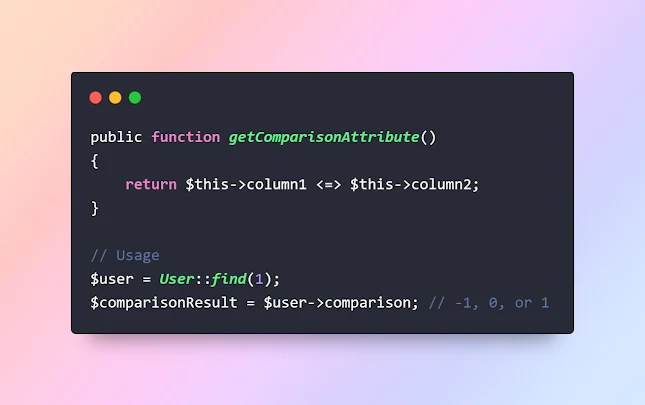{tocify} $title={Table of Contents}
Introduction
Laravel, the popular PHP framework, provides developers with a wide range of powerful features and functionalities. One of the fundamental aspects of working with databases in Laravel is comparing columns within the same model. This capability allows developers to perform various operations, such as filtering, sorting, and aggregating data based on column comparisons. In this article, we will explore different methods to compare two columns within the same Laravel model, providing you with a comprehensive understanding of each technique and its use cases.
Method 1: Using Eloquent `whereColumn`
The first method we'll explore is leveraging the Eloquent ORM's `whereColumn` method. This method provides a simple and intuitive way to compare columns within the same model. By specifying the two columns you want to compare, along with an optional operator, you can easily retrieve the desired results.
For example, if we have a "users" table with columns "age" and "retirement_age," we can retrieve all users who have reached retirement age using the following code snippet:
$users = User::whereColumn('age', '>=', 'retirement_age')->get();The whereColumn method allows us to specify various operators such as greater than, less than, equal to, etc., enabling us to perform different types of comparisons effortlessly.
Method 2: Utilizing Raw Expressions
While the whereColumn method is convenient for simple comparisons, there may be scenarios where you need more control over the comparison logic. In such cases, raw expressions can come to your rescue. Raw expressions allow you to write custom SQL code within your Laravel queries.
By utilizing raw expressions, you can leverage the full power of SQL operators and functions to perform complex comparisons. For instance, let's say we have a "products" table with columns "price" and "discount_percentage." We want to retrieve all products where the final price after applying the discount is less than $50. Here's how you can achieve it using raw expressions:
$products = Product::whereRaw('price - (price * discount_percentage / 100) < 50')->get();With raw expressions, you can perform mathematical calculations, use SQL functions, and even incorporate subqueries into your comparisons, providing you with unparalleled flexibility.
Method 3: Adding a Custom Accessor
In some cases, you may want to compare attributes within your model rather than performing the comparison directly in the query. Laravel allows you to define custom accessor methods within your model to manipulate attribute values.
By creating a custom accessor method, you can perform the desired comparison and retrieve the result as a virtual attribute. This approach is useful when you need to perform additional transformations or logic before comparing the columns.
Let's consider an example where we have a "students" table with columns "marks_obtained" and "passing_marks." We want to determine whether a student has passed or failed based on these columns. We can define a custom accessor method named "isPassed" within our "Student" model:
public function getIsPassedAttribute()
{
return $this->marks_obtained >= $this->passing_marks;
}Now, whenever we access the "isPassed" attribute on a "Student" model instance, Laravel will automatically invoke the "getIsPassedAttribute" method and return the result of the comparison.
Method 4: Leveraging Query Builder
For complex comparisons that involve aggregations, subqueries, or more advanced SQL functionalities, Laravel's Query Builder provides a robust solution. The Query Builder allows you to construct complex queries using a fluent, chainable interface.
To illustrate this method, let's assume we have an "orders" table with columns "total_amount" and "average_amount." We want to retrieve all orders where the total amount is greater than the average amount. We can achieve this using the selectRaw and whereRaw methods of the Query Builder:
$orders = DB::table('orders')
->selectRaw('id, total_amount, average_amount')
->whereRaw('total_amount > average_amount')
->get();The selectRaw method allows us to specify raw SQL expressions in the SELECT clause, while the whereRaw method enables us to define custom comparison logic in the WHERE clause.
Conclusion
Comparing two columns within the same Laravel model is a common task in database-driven applications. By exploring different methods like Eloquent's whereColumn, raw expressions, custom accessors, and Query Builder, you now have a diverse set of tools at your disposal to tackle various comparison scenarios. Whether you need a simple column comparison or a complex query involving aggregations and subqueries, Laravel provides the flexibility and expressiveness to handle it all. So, go ahead and boost your Laravel skills by applying these techniques in your projects, and unlock new possibilities for data manipulation and analysis. Happy coding!






0 Comments